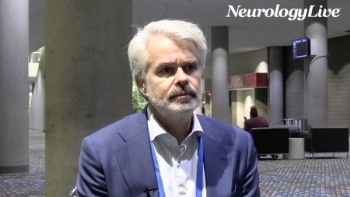
NeuroVoices: Elisabeth Sonesson, PhD, on Imlifidase’s Targeted, Fast-Acting Approach to GBS
The vice president and franchise lead of Autoimmune at Hansa Biopharma shed insights on imlifidase’s targeted mechanism and promising phase 2 data in treating Guillain-Barré syndrome.
At the
Imlifidase, an approved treatment in Europe for desensitizing kidney transplant patients, led to swift and enhanced symptoms, with improvements observed within 1 week following treatment. After 8 weeks from treatment, 67% of patients were able to walk independently, 40.7% of patients had regained the ability to run, and 37% of the patients had improved by at least 3 points on the GBS Disability Scale. In addition to a safe profile, these data further reinforced the therapeutic potential of imlifidase in treating GBS.
In a new iteration of NeuroVoices, Elisabeth Sonesson, PhD, VP, Franchise Lead, Autoimmune at Hansa Biopharma, sat down to shed insights on the latest data and reasons behind imlifidase’s early-stage success. She outlined the trial design, which paired the novel enzyme therapy with standard-of-care IVIg, and highlighted the rapid functional improvements and favorable safety profile seen in treated patients. Sonesson also reflected on the unmet need in GBS care, explaining how imlifidase’s specific, fast-acting mechanism may offer a meaningful advantage over current therapies. Finally, she discussed plans for publication and further development as the company evaluates next steps.
NeurologyLive: What is the rationale behind why imlifidase can be successful in treating GBS?
Elisabeth Sonesson, PhD: Imlifidase is a first-in-class enzyme that specifically cleaves human IgG molecules. By doing that, it converts the IgG molecule into an Fc part and an F(ab')2 part, eliminating the Fc-mediated functions of the IgG. From an infusion of imlifidase into the patient, within hours the IgG levels drop to below detection limits and stay suppressed for about a week. After that, newly synthesized IgG begins to build back up, eventually returning to normal levels.
The rationale for using this in GBS is that a key driver of the disease is IgG autoantibodies directed against gangliosides, which mediate the inflammatory damage to peripheral nerves. The specific and fast mode of action of our molecule may translate into clinical benefit by rapidly removing the antibodies that cause this damage.
Can you provide an overview of the 15-HMedldeS-09 study?
Imlifidase originates from a bacterial enzyme found in S. pyogenes called IdeS. This was an open-label, single-arm trial conducted in France, the UK, and the Netherlands. We enrolled patients with severe GBS—defined as a GBS disability score of 3 or higher. Initially, 30 patients were enrolled, but three were later re-diagnosed with other conditions, leaving 27 patients in the final analysis.
All patients received imlifidase followed by the standard five-day IVIG course (0.4 g/kg/day), beginning 48 hours after imlifidase administration. We assessed efficacy outcomes like GBS disability score, MRC sum score, R-ODS, hospitalization metrics, and need for mechanical ventilation. Safety and tolerability were also major focus areas, since this was the first time the drug was used in this patient population.
What considerations were made during the design of the trial?
Because this was the first study using imlifidase in GBS, we prioritized safety. That’s why we designed the trial to combine imlifidase with the current standard of care—IVIG. The 48-hour delay before IVIG administration was chosen to allow imlifidase to act first and eliminate IgG.
We also wanted to extract as much information as possible from this exploratory trial. So we included a wide range of efficacy, safety, and quality-of-life endpoints to better understand where the treatment might offer benefit.
What were the major takeaways from the data presented at PNS 2025?
The oral presentation at PNS 2025 focused on the outcomes from this phase 2 trial. The two main takeaways were, first, that imlifidase followed by IVIG was very safe and well tolerated. Second, the efficacy results were very encouraging.
Patients showed rapid functional improvement. GBS disability scores improved quickly after imlifidase treatment, and MRC sum scores rose from 39 to 50 in just the first week. Although it was a small, single-arm study, we also conducted a comparison with the IGOS cohort. There, we saw that patients treated with imlifidase and IVIG regained the ability to walk six weeks earlier than those treated with IVIG alone.
What conversations has the company had about potentially advancing this agent?
First, we plan to publish the results in a peer-reviewed journal, because we think these are meaningful findings. After that, we’ll be in a better position to define and share our next steps for the clinical development of imlifidase in GBS.
What does this drug bring to the GBS treatment landscape that differs from current options?
It brings specificity and speed. Imlifidase specifically removes pathogenic antibodies very rapidly. Current standard-of-care IVIG takes five days to administer and has a slower onset of action. We know there is a significant unmet need in GBS—25% of patients require mechanical ventilation, and many are still unable to walk a year after diagnosis. A treatment that can quickly remove harmful antibodies may help change that trajectory.
What does the safety profile look like? Were there any notable adverse events?
No significant concerns. We didn’t observe any treatment-emergent adverse events that led to discontinuation. There was one infusion-related reaction that required a temporary pause, but the full dose was still administered. No clinically relevant changes were observed in ECGs, vital signs, or infection rates. We concluded that imlifidase was safe and well tolerated in this population.
Transcript edited for clarity.
REFERENCE
1. Attarian S, Magy L, Echaniz-Laguna A, et al. Outcomes in Patients with Severe Guillain-Barré Syndrome Treated with Imlifidase and Standardof-Care Immunoglobulin. Presented at: 2025 PNS Annual Meeting; May 17-20; Edinburgh, Scotland. Abstract O582.
Newsletter
Keep your finger on the pulse of neurology—subscribe to NeurologyLive for expert interviews, new data, and breakthrough treatment updates.































